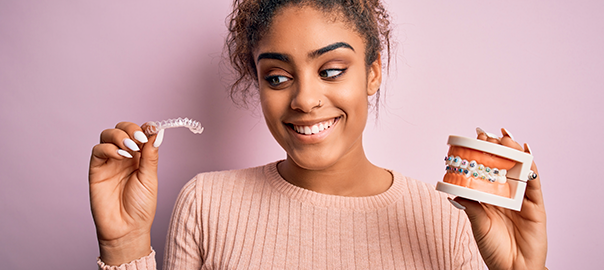


Smile correction is the third-largest treatment category in the field of dentistry. Along with a shiny and bright smile, straightened and aligned teeth are now one of the prime requisites for many people in India. The benefits of orthodontic treatment do not end with a straight smile. It also aids in maintaining proper oral hygiene, preventing decay, and getting rid of many underlying gum diseases. But one of the major questions arises in the mind of many when it comes to getting orthodontic treatment done. The decision between aligners vs braces. This virtual tool will help you solve your problem and get a proper answer. Let us discuss this in detail.
ALIGNERS AND BRACES
Clear aligners: Aligners are plastic and customized orthodontic tools to fit your teeth. Each aligner makes little movement possible in your teeth to push it to its final position. Small lumps of composite resins are also attached between teeth to help the aligner make a tighter grip around the tooth.
Conventional braces: We are all well-versed with the conventional orthodontic treatment used since ancient times: braces. It can be both clear braces and metal braces. Consisting of brackets fixed onto the teeth, connected through wires and small rubber bands. These wires and brackets keep the teeth under a constant force, yet gentle, to align the teeth.
DIFFERENCE BETWEEN CLEAR ALIGNERS AND METAL BRACES
Treatment length: This usually varies according to different individuals. Conventional braces may take between 1 to 3 years, while aligners can align the teeth between 6 months to 2 years, depending upon the individual case.
Removable: We all know that metal or conventional braces are fixed appliances. They stick onto the tooth surface and then are joined with a wire. Meanwhile, it is not the case with aligners. Clear aligners are removable orthodontic appliances and can be worn according to patients’ convenience.
Cleaning: Many people are afraid of getting metal braces because they are hard to clean. Metal braces require more attention when compared to aligners in case of cleaning. Regular brushing, flossing, and routine dental visits are a must for metal braces. Though in the case of clear aligners maintaining cleanliness is relatively easy.
Maintenance: Conventional metal braces require regular and thorough cleaning, scheduled orthodontic visits, and abstinence from certain foods. But clear aligners are slightly different. Being removable appliances, they need to be worn 22 hours a day. Regular cleaning and flossing of both the mouth and aligners are a must, and they need to be soaked in water all night.
The ideal treatment for: Metal braces is quite visible in the oral cavity. It is not a fit option for working professionals and image-conscious patients. Metal braces are usually suitable for kids and teenagers. At the same time, clear aligners are a perfect choice for adults.
5 THINGS TO BE CONSIDERED
After getting a gist of the differences between aligners and braces, if you are still weighing your options. This might help you. Here is a list of 5 factors, and considering the following factors, you can choose what’s most important to you.
Cosmetics: This factor is important to many people. For patients who do not want to brag about their ongoing dental treatment, loud and proud, clear aligners are the best choice. With metal braces, cosmetics are compromised.
Convenience: For patients who do not want long and repeated orthodontic appointments, convenience is a priority. Metal braces require two long appointments and short appointments at regular intervals. These appointments are usually scheduled once in two weeks. While in the case of aligners, the number of appointments required is usually fewer and is relatively shorter.
Compliance: The orthodontic treatment requires attention. Maintaining good oral hygiene is very important. Traditional braces are a good option for young teens and younger patients, say 8-14 years of age, because it takes a lot of accountability off their shoulders.
Comfort: For those who prioritize comfort over anything, clear aligners are a perfect choice. Traditional braces come with a variety of metal attachments and wires. These usually cause soreness on your cheeks, lips, and tongue. This is not the case with clear aligners. They are clear plastic appliances with no pokey metal and wire attachments.
Cost: Last but not least, cost is one of the important factors that should be considered. In this case, traditional braces are winners. These conventional braces are quite pocket friendly when compared to clear aligners.
Clear aligners are the incognito way to get your smile corrected. However, traditional braces allow you to wear colourful and creative appliances on your teeth. Every treatment has its pros and cons. But before drawing any conclusion, consultation of the professionals is a must. An orthodontist, after a checkup, will recommend the best treatment suitable for you. So do not hesitate and get your smile designed now.